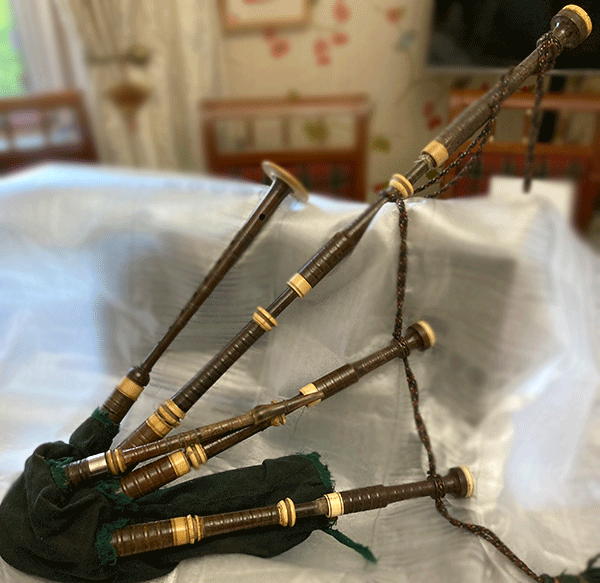
It was always a dream of mine that one fine day up in Highlandshire, when it was pouring down and I am making my way through the 43rd charity shop of the holiday, I would spot a manky old wooden box holding up a tea set in the display window.
Removing the china, I would fish out and blow the dust off the box to reveal on the lid the legend, ‘Donald Mòr MacCrimmon, keep your hands off if you know what is good for you‘. Inside would be a very old set of long neglected, but remarkably still playable bagpipes which I would then spirit away for the princely sum of ‘wan poun’ wan an’ wampence’.

By John Nevans
After some verification this would be the instrument of the old master himself and I would curate them for the rest of my days, occasionally blowing a tune on them and referring to them as ‘my precious’.
Has this happened? No! However, something like it has. This, dear reader is where I turn to the accumulated mental acumen of the piping community and ask you to assist me.
Here is the story. I have known of, and visited off and on, the West Lothian premises of Blue MacMurchie Bagpipes, ‘Blue’s Shop’ to you and me, aware that he held there a treasure trove of bagpipe parts and memorabilia.
On a recent visit he indicated that he was intending tidying things up and downsizing a bit. In one of his glass display cases he exhibited the old set of pipes pictured above. Long story short, I bought them.
I could see they were ancient even from outside the glass case and I enquired how he had come to have them in his possession. He told me that when Glen’s shop in the Royal Mile in Edinburgh closed in the early 1980s the contents were bought by a very well-known and accomplished solo piper from the Midlothian area. The whole lock, stock and barrel from the shop later transferred into Blue’s capable hands and he has looked after it ever since.
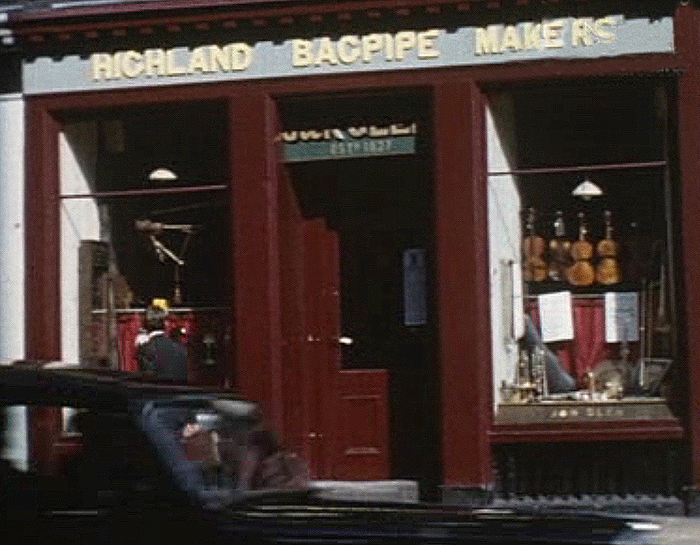
The old pipes on display were part of the job lot he had bought and that had been kept in the cellar of the Royal Mile workshop ‘for goodness knows how many years’.
Blue suggested that Glen’s may have taken them as part exchange on a new set of pipes and simply kept them until such times as they could be sold or come back into use in some way.
Considering that Glen’s shop closed in the early 1980s, there is at least a 40 year gap between then and now. And looking quickly at them, they may well have been stored in Glen’s for the same amount time again. This became one important aspect of this research.
Before I go on, does anyone have memories of Glen’s under Andrew Ross? Do you remember the shop? Please let me know.
So what do we have on our hands here? The pipe is complete at a broad, objective level. The wood used is the healthy brown/red of cocus wood. To go off at a tangent, cocus is also known as ‘Jamaican ebony’ and is found on that island and on Cuba. How did this wood come to be in Scotland in the 19th century? Can anyone throw some light on this thought?
On the drones there are several areas of ‘whipping’ – the process of binding a cracked section to draw the edges together, and over-coating the section with shellac, a form of early varnish. I have to say the process has worked remarkably well and the sections are all still sealed and fit for purpose.
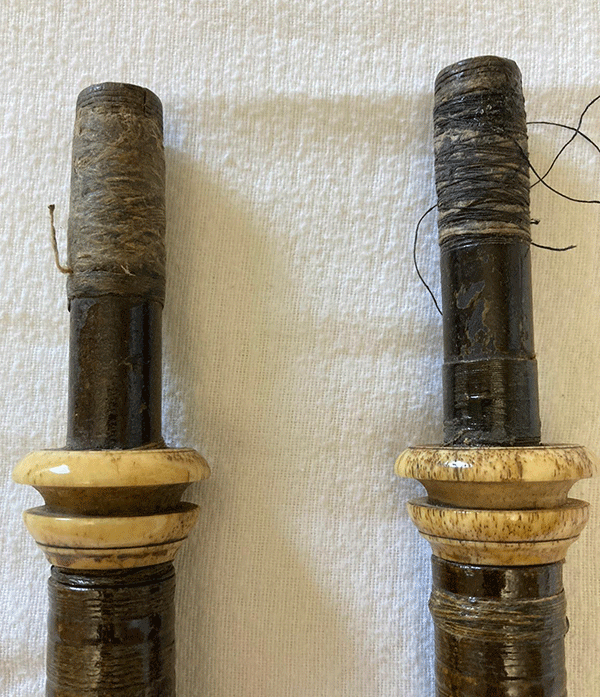
The drone-top bushes do leak but that is an easily remedied complaint. One tenor top does look more recent than the other sections, perhaps it had gone beyond ‘whipping’ and a prosthetic section has been created (see below).
The chanter is of a similar make to the rest of the pipe. I shoved a reed in it and put it into my Lawrie pipes. The reed sat deep in the seat but an untaped low A read at 469hz on the meter. Consider that modern soloists may find themselves at a starting pitch not much higher than this. Have a listen:
The C is quite a bit lower in pitch than the low A but this could have been a deliberate factor built into the chanter design to accommodate the reeds used at the time of manufacture. Again, there are those amongst you who will have researched this further so please feel free to share your experiences.
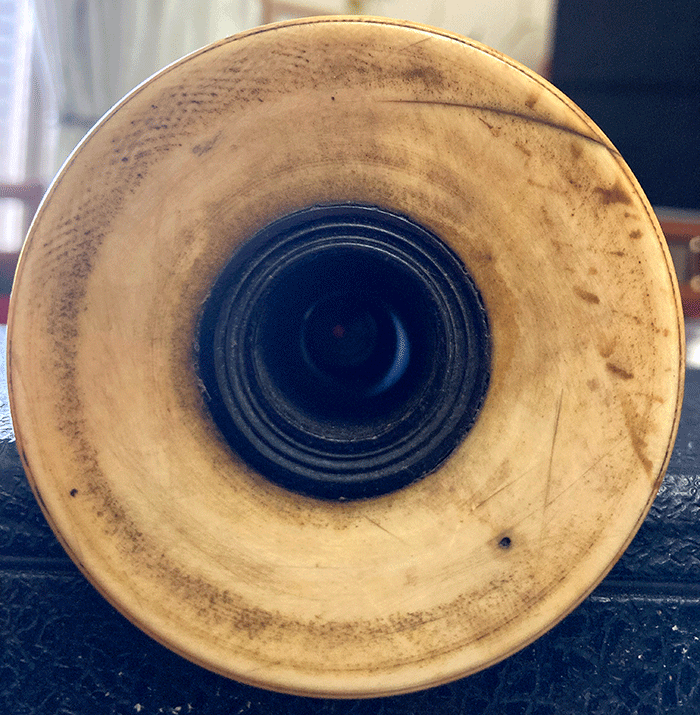
The projecting mounts and ferrules are of a natural substance; closer inspection shows an assortment of marine ivory, horn and bone. It may be that the pipes were originally decorated using only one of these, and as some have broken or fallen off they have been replaced by other materials. However it may also be the case that the maker used what was to hand and that matching continuity wasn’t important to him?

The bag is a small sheepskin and, as you would expect, appears dried out and likely porous. What I did observe was that there was attached to the arm side of the bag a curious flap of some kind (see pictures).
Closer inspection showed the flap lifted up to expose a reddish stained area in the middle of which I determined a hole in the skin. All the little ducks lined up and the flap proved to be of rubber and the effort to repair the hole was done using a bicycle tyre repair kit.
Now pneumatic tyres were first patented by Mr Dunlop in 1888, the dawn of the repair kit cannot have been far behind I would imagine. So this does not really help us with the age of the pipes, though it does raise a grin about the inventiveness of pipers when it comes to the cost of splashing out on a new bag.
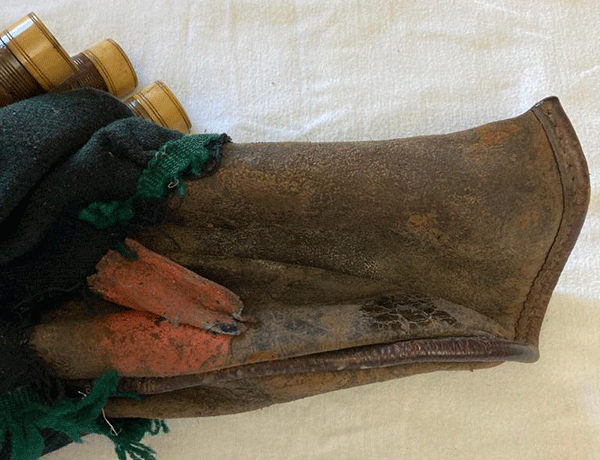
The drone cords and cover are of contemporary design. There is a little wear on the cover around the trim but a deft stitch with a needle will tidy that up and prevent further damage.
Now! Here is the bombshell. A visitor to Blue’s workshop in years gone by commented that this bagpipe was an exact sister pipe to one that was in this gentleman’s possession and which he had had verified as having been made by John Ban MacKenzie who made pipes from 1840 until 1867.
Could my pipe be a JB MacKenzie? This is an exciting prospect and one worthwhile pursuing. So if you have had sight of such a set and can give consideration to the pictures herein please share your thoughts and we can begin to build a vision of the origin of the instrument and recover a part of our history for future generations of players.
If after scrutiny they are not verifiable as John Ban MacKenzie pipes what we still have is probably an example of a pre-1850 bagpipe which is worthy of restoration (not refurbishment) and conservation.
The next part of the journey is tracking down the verifier, considering more fully the anecdotal evidence and delivering some conclusions.
- If anyone can help John please email us directly or better still leave a message in our Comment section.
-
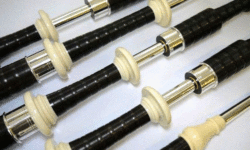 Bagpipes – DN4A – High Quality Set in Plain SilverPrice range: £200.00 through £2,052.00
Bagpipes – DN4A – High Quality Set in Plain SilverPrice range: £200.00 through £2,052.00 -
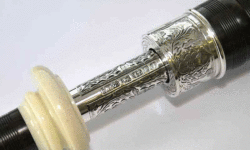 Bagpipes – DN5 – The Finest Bagpipe AvailablePrice range: £300.00 through £3,424.00
Bagpipes – DN5 – The Finest Bagpipe AvailablePrice range: £300.00 through £3,424.00 -
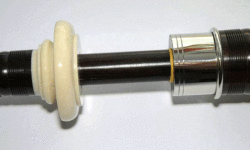 Bagpipes – DN1, High Quality InstrumentPrice range: £100.00 through £1,250.00
Bagpipes – DN1, High Quality InstrumentPrice range: £100.00 through £1,250.00
















Hello
My grandfather was the owner of Rosenbloom Brothers music shop in the North Bridge Arcade Edinburgh, just 300 yards from Glens shop on Castlehill. He was a great friend and both men often went into eachother’s shops. My grandfather sold famous German made gut violin strings which Glens used to stock for the many fiddles which they sold.
Our shop closed in 1968 after the death of my grandfather Mr Simpson Rosenbloom who established sheet music, instruments and strings etc as well as a huge gramophone records department from 1911 in the Arcade.
Hello from Brittany , I totally agree with Yves Tison that these pipes were made by Alexander Glen .
I have at home the replica of Yves’s set made by the late Pierre Blanchet and when I compare with the picture published on Piping Press , it is almost a clone of this set of bagpipes .
All the best
Patrick Molard
Hi Patrick
Thank you for your comments. These all go towards identifying and verifying the maker. Could you share any pictures you have of that set of pipes please and if I may might I ask if I can use them in the second part of my article. my email address is j.nevans@btinternet.com
Thanks again and best wishes
John
Hi John
I have a similar set but in better condition .
After 42 years of buying and selling pipes this set appeared on my counter . I did not know what to do with them at first as I had never seen similar . Were they junk or what but they intrigued me due to the age and came to conclusion they had worth and I spent from memory a reasonable sum to buy and at time thought mad to do so . I played them at the marque that I sponsored about 15 Years ago piping live and like you wanted to know maker and ask a few people to no avail . Alexander
Glen sounds the best option , Don’t have great modern look but good sound . Glad I bought and still have . Thanks interesting article
James Begg
As I understand things, Cocus wood was indidgenous to the West Indies as you relate, but it was also found in India, and with the days of the Raj and I’m sure much of it came to Scotland via this route.
Can’t help with the bagpipe but remember Glens shop clearly. I have a casebound scots guards collection I bought in 1980 ,it has the J And R Glen stamp on the inside cover. Any visit was an experience.
Robert “Barney” Barnes has a similar set of drones, might be of some help?
Hi from France
I have exactly the same set of pipes with walrus ivory mounts made by the reknown pipe maker Alexander Glen in the 1840s.
I have many pic to share
I have a sister set of this one as well.
What makes you lean towards Alex Glen? I tried comparing but still found many differences to clearly identified Glens …
Greetings
Hello, the lady who sold the pipes to me (her father’s pipes) found the invoice inside the wooden box : ALEXANDER GLEN 1840
But unfortunately the paper is lost.